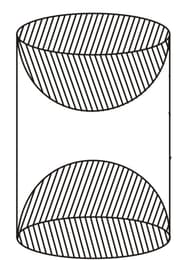Embibe Experts Solutions for Chapter: Surface Areas and Volumes, Exercise 1: CBSE-2022 (Delhi - II)
Embibe Experts Mathematics Solutions for Exercise - Embibe Experts Solutions for Chapter: Surface Areas and Volumes, Exercise 1: CBSE-2022 (Delhi - II)
Attempt the free practice questions on Chapter 13: Surface Areas and Volumes, Exercise 1: CBSE-2022 (Delhi - II) with hints and solutions to strengthen your understanding. EMBIBE CHAPTER WISE PREVIOUS YEAR PAPERS FOR MATHEMATICS solutions are prepared by Experienced Embibe Experts.
Questions from Embibe Experts Solutions for Chapter: Surface Areas and Volumes, Exercise 1: CBSE-2022 (Delhi - II) with Hints & Solutions
A wooden article was made by scooping out a hemisphere from each end of a solid cylinder, as shown in figure. If the height of the cylinder is , and its base is of radius . Find the total surface area of the article.

A heap of rice in the form of a cone of base diameter and height . Find the volume of rice. How much canvas cloth is required to just cover the heap?
The diameters of the lower and upper ends of a bucket in the form of frustum of a cone are and respectively. If its height is , find
(i) the area of the metal sheet used to make the bucket.
(ii) Why we should avoid the bucket made by ordinary plastic? [Use ]
Water in a canal, wide and deep, is flowing with a speed of . How much area will it irrigate in minutes; if standing water is needed? (write answer in )
A bucket open at the top is in the form of a frustum of a cone with a capacity of . The radii of the top and bottom of circular ends of the bucket are and respectively. Find the height of the bucket and also the area of the metal sheet used in making it.(Use )
Two cones have their heights in the ratio of and radii in the ratio . What is the ratio of their volumes?
A cone of base radius is divided into two parts by drawing a plane through the mid-point of its height and parallel to its base. Compare the volume of the two parts.
A bucket in the form of a frustum of a cone of height with radii of its lower and upper ends as and , respectively. Find the capacity of the bucket. Also find the cost of milk which can completely fill the bucket at the rate of per litre.
